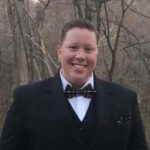Welcome back to the Healing Pain Podcast with Chris Condran, PT, DPT
I’m super honored that you’re spending this time with me. As many of you know, the month of June is Gay Pride or what is known as LGBT Pride Month across the globe. This is a time of celebration as well as one of increased awareness where the LGBT community promotes their equality, builds community and celebrate sexual diversity and gender variance. If you’ve been following along with the blog, I interviewed clinical psychologist, Lore Dickey, about transgender healthcare. Now, you’ll meet Dr. Chris Condran who is a Doctor of Physical Therapy to discuss LGBT inclusion in the physical therapy curricula and profession. Chris is an Orthopedic Physical Therapist and an instructor in the Transitional Doctorate of Physical Therapy Program at Arcadia University where he teaches health and wellness promotion as well as case analysis.
His educational background includes a Master’s in Exercise Physiology and MBA in business administration, a DPT in physical therapy and he’s enrolled in the EdD program at the University of North Carolina. He has personally advocated for curriculum change within physical therapy education and has created training material on the subject of LGBT inclusion in physical therapy practice. His research advocacy interests are centered on providing inclusive clinical environments, transgender health issues, eliminating health disparities in the LGBT population and establishing a curriculum for LGBT cultural competency in the classroom and beyond. He is also a board member of PT Proud, which is the LGBT catalysts committee under the Health and Policy Administration section of the American Physical Therapy Association.
On this episode, he will share some of his unique life experiences related to diversity, equity and inclusion of LGBT individuals in the physical therapy profession. If you’re a practitioner or potentially an educator and you’re interested in the topic of LGBT inclusion in physical therapy or any other medical practice, Chris and his colleagues had created an LGBTQ Competency Handbook for Physical Therapists. This is a free manual and you can download it which includes information about LGBT inclusion in both the clinic and the classroom. To download this handbook, all you have to do is text 138Download to the number 44-222. If you’re on your computer, you can open a new browser and you can type in the URL, www.IntegrativePainScienceInstitute.com/138download. Chris and the other members of PT Proud, would love if you can get your hands on that and put it to good use in both the clinic as well as in education. I want to personally thank Chris as well as my other colleagues at PT Proud for being a catalyst and making some bold moves and taking the step forward with this important topic. Without further ado, let’s begin with the amazing Chris Condran.
—
Watch the episode here:
Subscribe: iTunes | Android | RSS
LGBT Inclusion In Physical Therapy with Chris Condran, PT, DPT
Chris, welcome to the show. It’s great to have you here.
Joe, it’s great to be here. Thanks for having me.
I had Lore Dickey on talking about transgender issues, but I wanted to have someone specifically from the fields of physical therapy because I’m a physical therapist and you are too. We’re going to talk about all those topics on the show. First, tell us about what you’re doing in the world of physical therapy.
I’ve been an outpatient physical therapist on PRN with Select Medical so that I can moonlight as an instructor for Arcadia University. I’m back at school for a fifth-degree for an EdD in Kinesiology at UNC Greensboro. Hopefully, one day I can be a full-time therapist professor.
You’re transitioning slowly from clinical and eventually to teaching. You’re doing some teaching now, aren’t you?

I’m teaching part-time for Arcadia University. I teach health and wellness promotion and also the final capstone course with them writing a publishable case report.
I went to Arcadia for my transitional TPT and I took the class that you teach with the wonderful, Kerstin Palombaro.
I can’t say enough good things about Kerstin. I was a student of Kerstin’s also and she’s being great with mentoring me for the last few years and also during my degree program. I can’t say enough about her.
Her health and wellness promotion class is such a great class. She’s so open and lets people develop their own method around health and wellness. She told me that you have 400 students in the class or something like that.
We’re close to 600 students enrolled now in the Doctoral program throughout all of our cohorts. It’s grown quite a bit. We’re international now as well. We have students from all over the world, which is exciting to teach for sure because there are so many different perspectives. It’s interesting to see what each student’s passion is around and what’s important to them in their own local geographic area. Things that we don’t deal with here in the United States are so important in other areas. One of the ones that come to mind is parasite prevention. This is something we don’t talk about much here in the United States, but with such a big issue there for that student and that they wanted to make their health and wellness promotion program around that. That was really neat.
Where does that student live?
I want to say that it was Southeast Asia. We also get a lot of students from the Philippines and India. It’s interesting for me to create more cultural competency around those other areas. Kerstin has a lot of experience with volunteering in the adoption agency in China. She has a lot more experience in cultural competency around Asian cultures. I sometimes have to rely a little bit on her to learn more about that and become more culturally competent so I can serve our students a little better.
You’re both doing great work in that class and I appreciate the work you’re both doing. One day I’ll have Kirsten on this show and we’ll be talking about it. Tell me about the work that you’re passionate about, the work that I think no one has done yet in the profession and the work that we have to start to roll out.
There’s a select group of us who are trying to push a more inclusive LGBTQ environment in PT in general through many different venues. We’re trying to get more LGBT people in leadership roles in the APTA and other organizations to creating an inclusive curriculum for our students and making the PT field even in the academic setting more inclusive and welcoming to the LGBTQ community.
Let’s talk about PT education first. Does the curriculum include any competency for this topic in the curriculum?

There’s very little. I can tell you that when I went to school, this is how I got started on this. There was one slide on the topic in a cultural health disparities class. Now, there is starting to be a little more. I’ve been doing some guest lecturing here in Pennsylvania where I’m from and Kerstin has welcomed me with open arms to Widener to be able to share this material with her students at Widener. I’m very excited to start doing more of this. Hopefully, a bunch of us can start doing more of this in a nationwide type of environment. It was great after some of my lectures, some of my students at the schools that I’ve lectured have reached out to me and wanted to do in services in the clinics that they’re on clinical rotations. There’s a big need and it’s starting to take off and people are starting to get interested in this.
What is APTA like? Have they taken a stance on topics like this? These are hot button topics when they show up in the media. Eventually, professional organizations like the APA, the American Psychological Association has put out a number of statements, has our own association started to put out their opinion with regard to these types of topics.
We’re fortunate that the APTA has started putting out content in support of LGBTQ non-discrimination. The Trump administration and the Health and Human Services Department have put out some content and perspective policy around discriminating against LGBTQ people. Earlier or later in 2018, we also saw some policy around transgender issues and defining gender as binary and biological, at birth. Fortunately, through PT Proud venues, we’ve been pushing for the APTA to take some stances on this. Fortunately enough, we’ve been heard and the APTA stepped up and put out some strong statements in anti-discrimination. It is validating for LGBTQ-identifying therapists to see their professional organization supporting this stuff.
As professionals, if we followed what the current administration is putting out there, there may be an inherent conflict of interest with regard to providing care for a patient.
What the Health and Human Services Department just put out was saying that you can base your discrimination based on religious beliefs, that you can discriminate and withhold care from a patient. We’re already in a situation where the LGBTQ population is marginalized in our society anyways and is not very confident in the medical system and in the healthcare system in general. We’re very skeptical because we’ve experienced discrimination very frequently. The US transgender survey that Lore talked about, there were over 27,000 respondents. It was greater than 60% of individuals had experienced some form of healthcare discrimination at some point in their lives. That’s a lot of people to be experiencing discrimination when we’re pursuing a setting that’s supposed to help us and improve our health and wellness.
A lot of the new studies coming out are suggesting that LGBTQ people have poorer health outcomes and also poor self-rated health in general. We rate ourselves lower than our cisgender or heterosexual counterparts. That speaks volumes to what we’re experiencing as a community and where we need to start improving. PTs can do that. PTs get a whole hour with a lot of our patients, maybe not one-on-one, but we are able to interact with our patients in a different level than many physicians, nurses and other practitioners are able to do so.
Touch also plays a significant role in the type of connection that we are able to create with our patients so they feel more comfortable. The hope is that people feel more comfortable interacting with us. Some of the surveys aren’t suggesting that. There was one that came out of the University of Queensland, Australia. One of my PT Proud cochairs sent it to us. All of the concerns that a lot of us in the LGBTQ community have and that we’re experiencing were validated in the survey saying that, “Yes, most individuals are experiencing some type of discrimination. If they aren’t directly experiencing it, they fear discriminating experiences.” Our practitioners have a lack of knowledge around that. That’s what you were getting, Joe, when you’re asked about the curriculum.
When I reflect on a curriculum, this information did not show up anywhere. When I was in PT school, I wasn’t out of the closet yet but I remember being very uncomfortable in palpation labs and where you’re now interacting with people who may understand or not understand who you are and the things you’re comfortable with. How many hours should this show up in Doctoral training physical therapy curriculum?
Even if it’s a week-long intensive summer course on cultural competency around LGBTQ issues, I try to cram it into two to three-hour lecture. The first week is when I get them at Widener. A lot of this stuff could just be infused into the regular curriculum. I talked at Lebanon Valley College in Tonya Miller’s class and we were discussing access injustice in the healthcare system. It was great because I could just pop in there for an hour, add in some of this content around LGBTQ discrimination, how to improve access and what we can do as PTs to create an inclusive experience and an inclusive clinical setting to eliminate those barriers.
Let’s talk about that from a physical therapy practice perspective. What are the barriers toward physical activity?

The US transgender survey and there was another survey out of Europe by Johns and their colleagues that talked about transgender people that are experiencing around trying to access physical activity. I can personally speak to some of these things because I’ve experienced them myself. It’s the general lack of inclusive space like no gender-neutral bathrooms, no anti-discrimination policies and insufficient locker room facilities. Also, we’re seeing a lot of this now in PIAA and NCAA issues. We saw the judgment for the Olympic committees around who can participate based on gender identity and their hormone levels. There’s not a whole lot of inclusive policy around that. Chris Mosier is a transgender athlete who does predominantly endurance related races and triathlons and things like that. He has been instrumental in spearheading the transgender-inclusive policy within sports. The physical therapy could certainly jump on board and try to start advocating as well as an organization for those types of things. Many of our patients are athletes.
If we boil it down to the actual PT practice, whether it’s an outpatient orthopedic practice or potentially a practice that exists within a hospital setting, how do physical therapists make this community feel more welcome to come into an environment that may be intimidating for them?
From my perspective, there are two spaces there. I look at it from a patient experience content and then also from a clinical setting content. I’ll talk a little bit about the inclusive experience part first and I think this comes down to behaviors that are presented from the physical therapist. One of the big things that I like to touch on first is confidentiality. I use this first because one of the most important things we can do to create and establish a therapeutic relationship is maintaining HIPAA and not outing our patients. Unless this would be a case that might be an exception like if you’re a pelvic floor therapist or you’re on vacation and you have someone that’s covering for you. That might be a situation where you can have someone and disclose their surgical history and things like that because it’s going to be relevant to their care.
However, I jump in there. I’m a PRN therapist. I show up at a clinic and covering a total knee replacement. It’s not relevant to me what’s in their pants or under their clothes. I’m worried about their knee. Maintaining that relationship and maintaining that confidentiality is essential. In addition to that, there are a couple of things that we can do behaviorally as far as listening and recognizing that gender identity and sexual orientation exists on a spectrum. It’s not making assumptions that everyone is heterosexual or cisgender and also following their lead on that. It’s being able to actively listen to someone and hear them and understand what is going on with them around their gender identity and how they present. It’s using their preferred name rather than their legal name. It’s using their preferred pronouns rather than what’s on the medical chart and using our best judgment not to ask questions out of curiosity but asking questions out of necessity.
As I mentioned in that previous scenario around the total knee stuff, I don’t need to know what their surgical history is to treat a total knee. I shouldn’t be asking questions because I’m curious about where they are in their transition. Even for somebody who’s trans identifying, sometimes that’s like, “I would love to talk to this person because I’m going through a lot of this stuff at the same time. I might be able to create a therapeutic relationship.” Even myself, I have to back off of that because it needs to be about the patient’s experience. It’s about maintaining that and continuing with that. The last thing is understanding gender dysphoria. Lore talked a little bit about gender dysphoria. One of the big things around gender dysphoria is a malalignment between what is going on for you outwardly and what’s going on for you inwardly.
Things in our environment can trigger that dysphoria and you as the therapist don’t want to be that trigger. There are a couple of key things that we can do to make that happen. Always ask permission and explain what we’re doing while we’re doing it. If we want to touch or disrobe, we’re always asking permission and we’re explaining what we’re doing as we’re doing it. Understand that our body parts as people may make us uncomfortable. This goes for an inclusive environment in general for all bodies. If you’re overweight, maybe you’re not okay taking your shirt off, even if you are masculine identifying. When that person does need to disrobe or something like that, we’re making sure that we’re not acting in a way that’s surprised or judgment or ogling. I have my top surgery coming up at the end of June. Let’s say I’m in recovery and I wipe out sledding with my son in December in the snow. I tear my rotator cuff and I need to go in for some therapy. I’m masculine presenting and you asked me to take my shirt off. At first, I’m apprehensive because I have these large scars from my top surgery but eventually, I comply and I take my shirt off. I would hope you as the PT would not be like, “What happened to you?”
We need to understand that’s what happens when someone has this procedure done. If a woman has a mastectomy because of breast cancer, if she takes her shirt off, we don’t want to be making her feel some type of way about her scars. The same goes for the transgender community and just understanding that and being able to provide modesty through providing gowns, sheets and making sure that the patient is comfortable. I would hope that we’re doing this with everybody. I can even speak to my own practice. Sometimes I get relaxed especially when we have a cooperative patient and we forget about those things. Keeping that in check and making sure we’re going back to those general patient modesty things helps.
From a clinical setting standpoint, there are a couple of things I will emphasize. Gender-neutral bathrooms are one big thing and also inclusive paperwork. I did give the handbook that PT Proud created. There are examples of inclusive paperwork in there as well as non-discrimination policies within your clinical organization that protect against discrimination for LGBTQ people. If I can give any takeaway, it is to take the time to educate yourself. That therapist that’s never seen anybody who’s had a bilateral mastectomy might want to go online and look at some images of that so that they feel more comfortable around that. Take some time to explore.
There’s so much content online around medical procedures and things like that now. Take some time to look at those things online so that you know what to expect, what you’re understanding and what your patient may have gone through and what complications they may be experiencing. There’s so much chronic pain in the transgender community post surgery because many of these surgeries are so invasive. Honestly, medicine hasn’t quite caught up to us yet, so the outcomes aren’t always as successful as we would hope they would be. Some of these people experienced chronic pain throughout the rest of their lives just to be authentic and feel aligned. That’s a big part of understanding us.
Much of what you said is so important to people who treat chronic pain. We can talk about the physical aspect of it and a lot of it also revolves around the psychosocial aspects of it, which we know is important in chronic pain in general. It’s especially important when you talk about the LGBTQ community who may have had adverse events happen in their life prior, whether it’s in their home life or whether it’s interacting with other medical professionals. A lot of what you’re saying echoes some of the good psychosocial skills that we’re trying to develop as professionals. Now you can apply it to this specific group. Tell me about PT Proud. I know you’re deeply involved in this organization. Tell us about what the mission is and how it began.

PT Proud started when a group of students got together from Regis University and reached out to some of their professors and some of the other administrators. They started to spearhead this movement within the APTA. Some other academics jumped on board and we became a catalyst group under the health policy and administration section. Thank you so much to them for housing us and continuing to support our mission. Our mission is to improve healthcare access as well as empower our base, which is PTS, PTAs and PT students to feel supported in creating a more inclusive environment, supported and feeling not discriminated against in their own practice as well.
You’ve obviously put together a handbook, which I have the handbook and we’re going to give it as a free download. Thanks for including it. I started to read through the handbook and I was like, “This is nice work that all of you put together that you can read on your own if you want to educate yourself.” It belongs to a curriculum. Tell us a little bit about the handbook.
I’ll give a little shout-out to the rest of the authors there that are listed.
We should name their names. They are Felix Hill, Chris Condran, AJ Pluss, Lindsay Fons and Karla Bell. Then there’s an illustrator, Michael Zabala, who made some great illustrations.
A big thank you to everybody for their hard work and enabling this to be out there trying to help make a change. The handbook is designed to be a guide for clinics and clinicians to create more inclusion within their settings by educating themselves on things like pronouns and the experience of the LGBT community. What barriers they’re facing and what health disparities are common there. We’ve even put things in there around trauma-informed care and inclusive paperwork. There’s so much in there. It’s over 30 pages long. That’s also open access on our website at PTProud.org so feel free to jump on there. If you want to get involved with PT Proud or join, you can do so through joining the HPA. It’s under manage preferences under your HPA account and then you can go down and select which special interest groups and committees you would like to join.
All you have to do is check that box for PT Proud LGBTQ catalyst group on your owner membership. We’re going to be releasing some new content and a couple of webinars. I’m also trying to spearhead an LGBTQ affirming clinician directory. I’m hoping to make that a nationwide initiative that’s in the very early stages here. I’m looking to try to put that out in an ad form. We’re trying to get people to respond and jump on board for that so that we have something out there for our patients to feel comfortable seeking this information out. They know that they’re going into a clinic that is going to be validating of who they are.
There’s so much information here with regard to LGBTQ information. You also talk about health disparities, inequalities and things in here that people can use that relate to other populations. You mentioned providing trauma-informed care. I don’t know if that shows up in a current curriculum. Can you talk about trauma-informed care just a little bit with regard to maybe the transgender community?
The biggest thing that we need to understand in our approach as PTs is that touch can be either therapeutic or not therapeutic as an invasive and triggering for people, especially those who have experienced trauma. Unfortunately, the transgender community experiences trauma at an extremely high rate. In the last few months, there have been three attacks and murders of transgender women of color, one in Philadelphia and the other one was in Texas. This is happening all the time. Regardless of whether it’s covered on the mainstream media or not, it’s happening every day. These people are experiencing this trauma and they’re coming for care. As PTs, a lot of times we’re desensitized to touch. We all go with the class, we all get touched, we all touch each other and then we get desensitized to the impact of touching and being touched.
I was talking about understanding gender dysphoria as well as asking permission and explaining what we’re doing. If someone says no and that they’re not comfortable, don’t go on to press the person to try to get them to do what you want to do. It’s being creative in what you’re doing and thinking back to how you can adjust your treatment so that you can best match what your patient is comfortable with. It’s just like what we would do with any other intervention there, but also employing some of those active listening skills especially when we’re doing patient history. Take the time to educate yourself on what may be some warning signs of what someone who’s experienced trauma may present with because they may not share that with you.
Paint a picture for me. This is all relatively new in the PT world. What’s your vision for transgender equality in the PT profession?

That’s a hard question for me to narrow down, but I tend to be ambitious around this stuff. Providing at the bare minimum and creating an inclusive curriculum in our academic settings as well as in our continuing education settings. I’m not just talking about pelvic floor stuff because that’s where we’ve seen this content before. I would like to see this in general practice. A lot of our states are getting direct access and we need to know how hormone levels might impact a patient’s response to therapy. We need to know what other comorbidities may be occurring because they’ve had surgery or they’ve had gender affirming hormone therapy. In addition to that, it’s creating those inclusive spaces and creating that inclusive experience that we talked about.
Another big one that APTA is starting to come about with is having out LGBTQ individuals in the leadership as well as in the classroom. Part of the reason why our field, in general, has been slow coming about on this because of the fact that many of our students don’t see us in leadership. They’re less inclined to come to join and feel comfortable because there is no one else like them. I went to a school where everyone was cisgender and heterosexual that was in my leadership that were my professors. For me, that was difficult in a way. I’ve always lived my life out and open and I’ve been out since I was fifteen. It’s still hard to feel comfortable to pursue certain situations. For example, what do I wear in a clinic because I haven’t transitioned? It’s those kinds of issues. Is it okay for someone to touch me when I’m not comfortable with it? Saying those things is difficult if you don’t foster the right environment.
In addition to that, the LGBTQ people in our profession, oftentimes we don’t place much value on them. That’s something that we need to start doing a better job of like valuing them in the leadership roles, valuing them in the classroom, using affirming language and creating inclusive environments. A big thing that would convey that to me as a transgender individual would be for the things that are happening for me to be included in the Guide to Clinical Practice. A full spectrum of health issues is covered in the Guide to Clinical Practice except for being transgender. The gender affirming procedures and treatments that we receive are nowhere to be found in there.
Clinicians have to go elsewhere like to the WPATH Standards of Care to be able to better understand what is happening for their transgender patients. We could do all those things as well as respect us and normalize the fact that gender exists on a spectrum and it’s not something that’s taboo. We’ve been around for centuries and we’ve been around since the dawn of time. There are lots of aboriginal and indigenous cultures that have us in them, like the Native American culture with the two-spirit identity. Those are the big things for me. If we lived in this utopia, we would be a representative in every space of the field. That’s ambitious but it could happen.
Let’s make it happen, Chris. The work you’re doing is great. When I opened this handbook, I was like, “A group of you started to create a movement, which is what we need.” There are other professions like the nursing profession. This has been already infused into the profession so we can maybe look at a model there, but I believe this is needed in the PT profession as well and the time is now. All of you have a great start here and you have my support. Thanks for being with me on the show and talking about this topic. Let everyone know how they can learn more about you and PT Proud and all the work that you’re up to.
If you would like to join PT Proud or find out more about these topics, we have a whole resource section at PTProud.org. If you want to know more about me, you can just search me on LinkedIn. I don’t have a website yet. Feel free to reach out by email. If you want to join PT Proud and the movement and have questions or ideas to get involved, we’re always looking for new inspiration and we love anybody who’s passionate and excited about this content. We’re going to be having new elections coming up for board positions and things like that and we’re always looking to increase the diversity of our leadership. Please reach out to us. We love to get more people involved and that’s how I got involved. I just emailed a student and here I am able to fulfill my hopes, dreams and passions through this channel. It’s exciting stuff, so please reach out.
I want to thank Chris for being on the show. That URL is www.PTProud.org. You can also tweet to @PTProudAPTA on Twitter and you can also tweet to Chris at @ChrisCondran. Thanks, Chris, for being on the show and for sharing this important information on LGBTQ competency, which is so important in the PT profession. Make sure to share this information out with your friends and family on Facebook, Twitter, LinkedIn or your favorite social media handle and stay connected to the show. Thank you very much and we’ll see you all next time.
Important Links:
- Lore Dickey – Previous episode
- Dr. Chris Condran
- Transitional Doctorate of Physical Therapy Program
- PT Proud
- LGBTQ Competency Handbook for Physical Therapists
- www.IntegrativePainScienceInstitute.com/138download
- Select Medical
- WPATH Standards of Care
- LinkedIn – Chris Condran
- @PTProudAPTA – Twitter
- @ChrisCondran – Twitter
- @PTProud – Facebook
- https://www.PTProud.org/
- How-to-join-PT-Proud
About Chris Condran, PT, DPT
 Chris Condran is an outpatient orthopedic physical therapist with 6 years of clinical experience. He is an Instructor of Physical Therapy in the online transitional doctorate program at Arcadia University. He teaches in the areas of Health and Wellness Promotion and Case Analysis.
Chris Condran is an outpatient orthopedic physical therapist with 6 years of clinical experience. He is an Instructor of Physical Therapy in the online transitional doctorate program at Arcadia University. He teaches in the areas of Health and Wellness Promotion and Case Analysis.
Dr. Condran’s educational background includes a BS in Exercise Science (East Stroudsburg University, 2006) MS in Exercise Physiology (West Chester University, 2009) MBA in Business Administration (Widener University, 2014) DPT in Physical Therapy (Widener University, 2013) and is currently enrolled in an EdD in Kinesiology (University of North Carolina Greensboro). He also holds certificates in Healthcare Management (Widener University, since 2013), as a Certified Exercise Physiologist (American College of Sports Medicine, since 2006) and as a Certified Conditioning Specialist (National Strength Professionals Association, since 2004).
He has personally sought to create curriculum change at his alma mater Widener University where he has been lecturing on the intersections of LGBTQIA+ identities and physical therapy clinical practice. Chris’s research and advocacy interests are centered in providing inclusive clinical environments for all patients, transgender health issues and the intersections of PT clinical practice, eliminating health disparities in the LGBTQIA+ populations, and establishing a curriculum for LGBTQIA+ cultural competency in the classroom and beyond.
Chris has found an outlet for these interests as a board member of PT Proud the LGBTQIA+ Catalyst Group/Committee of the Health Policy & Administration Section of the American Physical Therapy Association, where he serves as the education liaison. Chris has also shared his unique life experiences with multiple panels related to the diversity, equity, and inclusion of LGBTQIA+ individuals.
The Healing Pain Podcast brings together top minds from the world of pain science and related fields to discuss the latest findings and share effective solutions for persistent pain.
If you would like to appear as an expert speaker in an episode of The Healing Pain Podcast contact [email protected].
Love the show? Subscribe, rate, review, and share!
Join the Healing Pain Podcast Community today:

